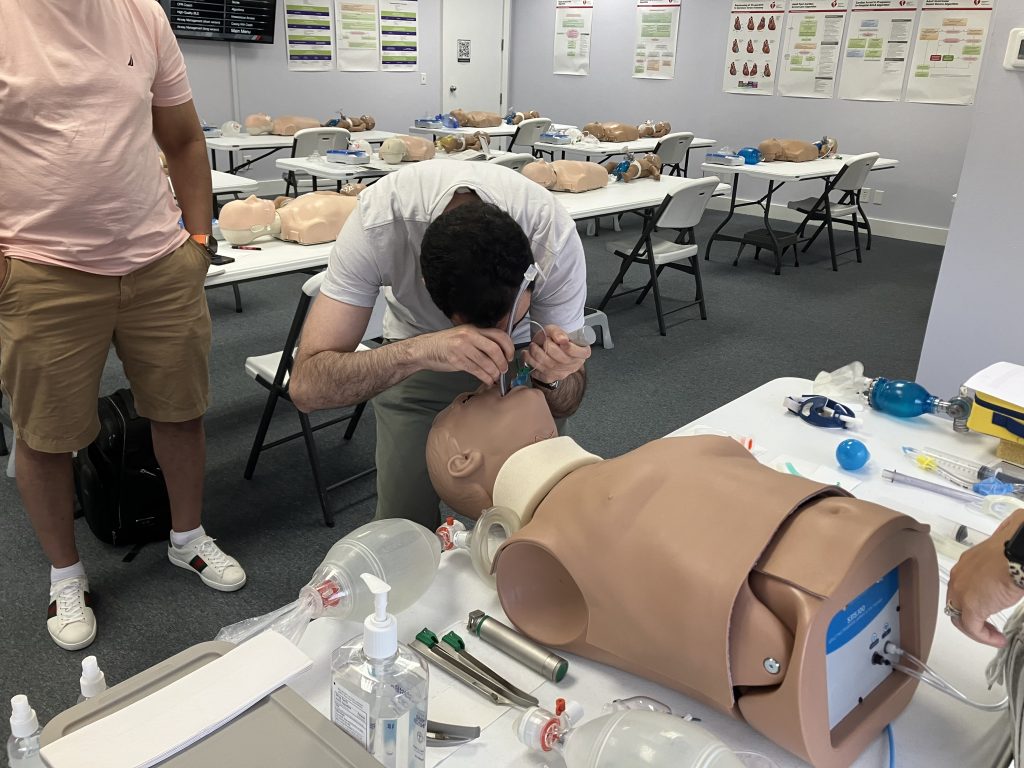When cardiac arrest strikes, every decision matters. Advanced airway management represents a critical intervention that can mean the difference between life and death. Healthcare providers face a delicate balance: delivering adequate oxygenation while maintaining high-quality chest compressions. Recent research from the Journal of Anesthesia, Analgesia and Critical Care reveals that effective ventilation is one of the two main keys to successful resuscitation, yet significant questions remain about optimal ventilation strategies during cardiac arrest.
Understanding Advanced Airway Management
Advanced airway management involves securing a patient’s airway using specialized devices that go beyond basic techniques. These interventions create a defined pathway for oxygen delivery and protect against aspiration during critical moments.
Types of Advanced Airways
Healthcare providers have two primary options for advanced airway management. Endotracheal intubation (ETI) involves placing a tube directly into the trachea, providing the most secure airway. Studies from the National EMS Information System spanning 2018 to 2023 show that ETI remained the predominant choice, though its use decreased from 82.3% to 69.2% during this period. Supraglottic airway devices (SGAs), including King airways and laryngeal mask airways, offer a less invasive alternative that can be placed without direct visualization of the vocal cords.
A 2024 study in the Journal of Anesthesia, Analgesia and Critical Care found that mechanical ventilation with automated transport ventilators is superior to manual ventilation. Manual bag-mask ventilation often delivers uncontrolled volumes and pressures, which should be avoided during resuscitation efforts.
Critical Decision Points in Ventilation for Advanced Airway Patients
The choice between bag-valve-mask (BVM) ventilation and advanced airways depends on multiple factors. BVM remains effective for initial airway support and can be successfully used throughout resuscitation when performed correctly. However, prolonged resuscitation efforts, high risk of aspiration, or inability to maintain adequate ventilation with BVM may warrant advanced airway placement.
According to the 2025 American Heart Association Guidelines, healthcare professionals should master both an advanced airway strategy and a backup strategy. This dual-competency approach ensures patient safety when the first-choice method proves unsuccessful.
Chest Compressions When an Advanced Airway Is in Place
Once an advanced airway is secured, the entire approach to CPR transforms dramatically. This change represents one of the most significant shifts in resuscitation protocols.
The Shift to Continuous Compressions
The 2025 ACLS guidelines emphasize a fundamental principle: when an advanced airway is employed, providers must abandon the traditional 30:2 compression-to-ventilation ratio. Instead, the compressing provider delivers continuous chest compressions at a rate of 100 to 120 per minute without pauses for ventilation. This approach maximizes cardiac output and cerebral perfusion.
Research published in the American Heart Association’s 2019 Focused Update demonstrates that interrupting compressions for ventilation compromises venous return and cardiac output. The continuous compression technique maintains coronary and cerebral blood flow, which directly correlates with improved survival rates.
Precise Ventilation Timing for Advanced Airway Patients
While compressions continue uninterrupted, ventilation must follow strict timing guidelines. The 2025 ACLS updates specify that providers should administer one breath every six seconds, delivering exactly 10 breaths per minute. This careful timing ensures consistent oxygen delivery without disrupting the rhythm of chest compressions.
Each breath should provide only enough air to make the chest visibly rise. Overventilation represents a common and dangerous mistake. Excessive ventilation increases intrathoracic pressure, reduces venous return to the heart, and decreases cerebral blood flow through direct vasoconstriction. These physiological effects can significantly worsen patient outcomes.
Optimizing Chest Compression Quality
High-quality compressions remain paramount even after advanced airway placement. Providers must compress the chest at least 2 inches deep in adults, allowing complete chest recoil after each compression. Full recoil facilitates venous return and optimizes cardiac output.
The 2025 guidelines recommend maintaining a chest compression fraction (CCF) of at least 60%, though high-performance teams may achieve levels exceeding 80%. CCF measures the proportion of time during cardiac arrest that compressions are performed. Studies show that minimizing interruptions and maintaining higher CCF correlates with improved outcomes.
Monitoring Ventilation in Advanced Airway Patients
Effective monitoring separates successful resuscitation from failed attempts. Modern technology provides healthcare providers with real-time feedback on ventilation adequacy.
Waveform Capnography: The Gold Standard
The 2025 ACLS guidelines assign the strongest recommendation to using quantitative waveform capnography alongside clinical assessment for confirming and monitoring endotracheal tube placement. This technology provides continuous, objective feedback on airway status and ventilation efficacy.
Waveform capnography displays both a numerical end-tidal CO2 (ETCO2) value and a graphic waveform. When a device is placed correctly, both appear within seconds after the first ventilation. Multiple studies have documented unacceptably high rates of misplaced endotracheal tubes when capnography was not used, even when other confirmation techniques suggested correct placement.
One study revealed that equal breath sounds were documented in 95% of patients with unrecognized misplaced tubes. Another study found unrecognized misplacements in 23.8% of cases without capnography, compared to zero cases when it was used.
Interpreting ETCO2 Values During Resuscitation
ETCO2 values provide critical information about CPR quality and patient status. During cardiac arrest with high-quality CPR, ETCO2 typically ranges from 12.5 to 25 mmHg. Values below 10 mmHg suggest that efforts should focus on improving chest compressions and ensuring ventilation is not excessive.
An abrupt and sustained rise in ETCO2 to 35-45 mmHg often indicates return of spontaneous circulation (ROSC) before clinical signs become apparent. This early detection allows teams to adjust their approach promptly and reduce unnecessary interruptions to check for pulses.
Preventing Hyperventilation
Hyperventilation represents one of the most common errors in advanced airway management. Monitoring respiratory parameters closely prevents this complication, which is associated with decreased effective blood flow. By adjusting ventilation rates to maintain optimal carbon dioxide levels, resuscitation teams ensure their efforts support rather than compromise the patient’s physiological stability.
Evidence-Based Ventilation Strategies
Current guidelines synthesize decades of research into practical recommendations. Understanding these evidence-based strategies helps healthcare providers deliver optimal care.
Avoiding Excessive Ventilation Pressure
Pressure management during ventilation requires careful attention. Providers should deliver breaths over approximately one second, using only enough volume to produce visible chest rise. Conventional ventilation modes were not designed for cardiac arrest and show important limitations when used during CPR.
The 2024 research in the Journal of Anesthesia, Analgesia, and Critical Care indicates that specialized ventilation modes for resuscitation deserve more support and advancement through research activities. Chest compression synchronized ventilation (CCSV) represents one promising approach that warrants further clinical investigation.
Maintaining Airway Patency
Continuous monitoring ensures the advanced airway remains properly positioned throughout resuscitation and transport. The American Heart Association guidelines recommend observing a persistent capnographic waveform with ventilation in the field, during transport, on hospital arrival, and after any patient transfer.
Movement during resuscitation or transport creates a significant risk for airway displacement. Studies show that continuous waveform capnography detects dislodgement immediately, allowing prompt correction before patient deterioration occurs.
Coordinating Team Communication
Successful ventilation in advanced airway patients requires seamless coordination between team members. The person managing the airway must clearly communicate with the person performing compressions. This ensures compressions continue uninterrupted while ventilations are delivered at precisely timed intervals.
The 2025 ACLS updates emphasize a well-coordinated, team-based approach to resuscitation efforts with strong focus on communication and continuous quality improvement. Regular training and simulation exercises help teams maintain these crucial skills.
Special Considerations for Ventilation in Advanced Airway Patients
Certain patient populations and clinical scenarios require modified approaches to ventilation during advanced airway management.
Pediatric Considerations
Pediatric patients present unique challenges in ventilation for advanced airway management. While the same principles of continuous compressions with asynchronous ventilation apply once an advanced airway is secured, anatomical differences require modified techniques.
Studies examining pediatric out-of-hospital cardiac arrest ventilation practices found that proper ventilation rates remain crucial. Healthcare providers must be especially vigilant to avoid hyperventilation, as children are more susceptible to its adverse hemodynamic effects.
Trauma Patients
Trauma scenarios often complicate the management of advanced airways. Suspected cervical spine injuries require modified approaches that minimize head and neck movement. Despite these challenges, ensuring adequate oxygenation and ventilation takes priority, as hypoxia causes more immediate harm than potential spinal movement during airway management.
Patients with Obesity
Patients living with obesity face specific airway management challenges. These individuals require specialized approaches to positioning, equipment selection, and ventilation techniques. Healthcare providers must adapt their methods to accommodate anatomical differences while maintaining the same evidence-based principles of ventilation timing and monitoring.
Training and Competency in Advanced Airway Management
Maintaining proficiency in advanced airway ventilation techniques requires ongoing education and practice. Healthcare providers must regularly update their knowledge and skills to reflect current guidelines.
Simulation-Based Training
High-fidelity simulation offers an ideal environment for practicing advanced ventilation techniques with airways. Teams can rehearse coordination, timing, and troubleshooting in realistic scenarios without risk to actual patients. Regular simulation sessions improve both technical skills and team communication.
Quality Assurance Programs
Healthcare systems should implement robust quality assurance programs that review advanced airway management cases. Analysis of capnography data, compression quality metrics, and patient outcomes identifies opportunities for improvement and reinforces best practices.
Conclusion
Ventilation in advanced airway patients represents a complex but crucial component of resuscitation. The evidence is clear: continuous chest compressions at 100-120 per minute combined with precisely timed ventilations every six seconds optimize patient outcomes. Waveform capnography provides indispensable monitoring, confirming airway placement and guiding resuscitation quality.
As research continues to evolve, healthcare providers must stay current with the latest guidelines and evidence-based practices. Success in advanced airway management requires not just technical proficiency, but also excellent teamwork, communication, and commitment to ongoing learning.
Frequently Asked Questions About Ventilation in Advanced Airway Patients
What is the correct ventilation rate when an advanced airway is in place during CPR?
When an advanced airway such as an endotracheal tube or supraglottic device is in place, healthcare providers should deliver one breath every six seconds, which equals exactly 10 breaths per minute. This timing allows continuous chest compressions without interruption. The 2025 ACLS guidelines emphasize this approach because it maintains optimal blood flow while ensuring adequate oxygenation. Each breath should be delivered over approximately one second, providing just enough volume to produce visible chest rise without causing hyperventilation.
Why are chest compressions performed differently with an advanced airway?
Once an advanced airway secures the patient’s airway, the traditional 30:2 compression-to-ventilation ratio is abandoned. Instead, providers deliver continuous chest compressions at 100-120 per minute without stopping for breaths. This change is based on research showing that interrupting compressions decreases venous return, reduces cardiac output, and lowers cerebral perfusion pressure. The advanced airway allows asynchronous ventilation, meaning breaths can be delivered independently of compressions. This approach maximizes the time spent maintaining circulation, which directly improves survival outcomes.
How does capnography help during advanced airway management?
Waveform capnography serves three critical functions during advanced airway management. First, it confirms correct tube placement in the trachea within seconds after insertion. Second, it continuously monitors the airway throughout resuscitation and transport, immediately alerting providers to any displacement. Third, it provides real-time feedback on CPR quality through ETCO2 values. During cardiac arrest with effective CPR, ETCO2 typically measures 12.5-25 mmHg. Values below 10 mmHg indicate the need to improve compression quality or reduce excessive ventilation. An abrupt rise to 35-45 mmHg often signals return of spontaneous circulation before other clinical signs appear.
What are the most common mistakes in ventilating patients with advanced airways?
Hyperventilation represents the most frequent and dangerous error. Providers often deliver breaths too rapidly or with excessive volume, which increases intrathoracic pressure and impedes blood return to the heart. This reduces the effectiveness of chest compressions and worsens outcomes. Other common mistakes include interrupting compressions to deliver breaths (which should never occur once an advanced airway is placed), failing to monitor with continuous capnography, and not verifying airway placement after patient movement or transport. Healthcare providers must maintain strict discipline with ventilation timing: exactly one breath every six seconds, no more, no less.
Take Your Skills to the Next Level
Understanding ventilation in advanced airway patients is essential, but maintaining current certification ensures you can apply these techniques confidently during emergencies. Whether you need initial training or recertification, proper education makes all the difference in patient outcomes.
Ready to master advanced airway management? CPR Louisville offers comprehensive ACLS classes in Louisville taught by experienced instructors using the latest American Heart Association guidelines. Our stress-free, hands-on courses ensure you gain practical skills you can immediately apply in real-world situations.
Don’t let your CPR certification in Louisville expire. CPR Louisville is an American Heart Association training site that offers initial certifications and renewal in BLS for Healthcare Providers, ACLS, PALS, and CPR and First Aid courses. All classes are stress-free and hands-on, providing the confidence you need when seconds count.
Contact CPR Louisville today to schedule your training and join the ranks of healthcare professionals equipped with the knowledge and skills to save lives through proper advanced airway management and ventilation techniques.





